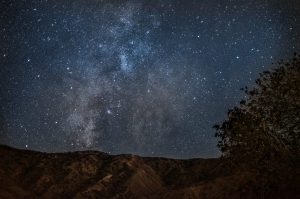
Everyone can remember their first time looking up at the sky on a beautiful clear night with stars covering the all you can see. Many people never really get to experience this living in cities with large lights blocking everything up in the sky. Here at CIMI we have the unique opportunity to live somewhere that does not have a lot of ambient city light. Since the beginning of man, stars have left people wondering what is up there to be discovered. The best way to learn is to go outside and look up!

Photo taken by Alex Krowiak on the canon loop trail, Toyon Bay.
People often times overestimate the number of stars they can see with just the naked eye, which under the very best conditions is only around 2,000 stars. In turn hundreds of billions of stars make up our Milky Way galaxy. It can be very overwhelming to imagine the amount of stars that occur in the billions of galaxies in our universe. This all makes us feel small here on earth, as well as wonder how thy all got up there.
Stars go trough a very complex lifestyle beginning with gas, dust, and ice condensing in a nebula. As the star shrinks the hydrogen ignites causing nuclear fusion. The hydrogen will continue burning steadily and the star will join the main sequence stars (meaning they have shed their birth cloud and are burning). When all the hydrogen in the core is used up the hydrogen in the outer shell will start burning. This process causes the star to become brighter and larger entering it in the class of a red giant. Winds will begin blowing on the star expelling the outer layers, which will in turn form a planter nebula. The nebula will expand leaving behind just a little hot core now called a white dwarf. The white dwarf will start to cool and fade away forever. Concluding the life cycle of a star.
Stars with a greater mass than the sun will eventually explode as supernovas and leave a neutron star or a black hole. And stars with a lower mass will remain a red dwarf forever. This whole process takes billions of years and gives us a basis for how many stars in the universe.


